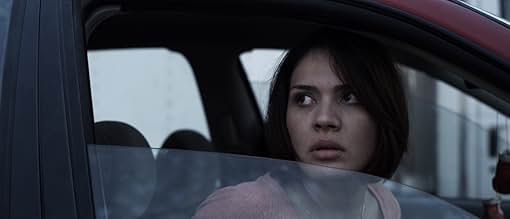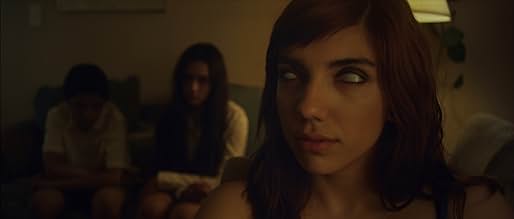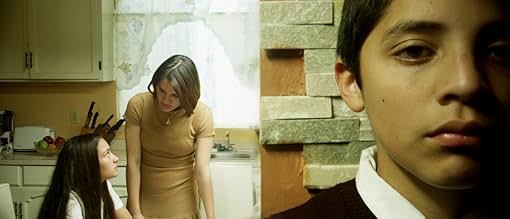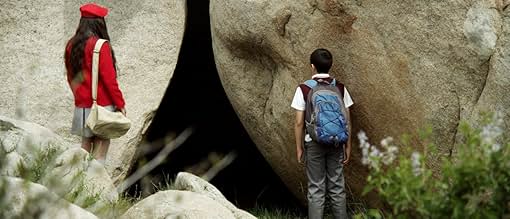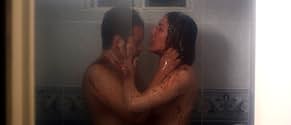IMDb RATING
5.6/10
4.6K
YOUR RATING
A couple loses their children near some caves in Tijuana. The children return to their parents the next day, unharmed. However, something has happened to them.A couple loses their children near some caves in Tijuana. The children return to their parents the next day, unharmed. However, something has happened to them.A couple loses their children near some caves in Tijuana. The children return to their parents the next day, unharmed. However, something has happened to them.
- Director
- Writer
- Stars
- Awards
- 6 wins & 3 nominations total
David Arturo Cabezud
- Lucio
- (as David Cabezud)
Enrique Saint-Martin
- Encargado
- (as Enrique Saint Martin)
Julio Granados
- Guardia
- (as Julio Cesar Granados)
- Director
- Writer
- All cast & crew
- Production, box office & more at IMDbPro
Featured reviews
This is a fairly straightforward story that lacks surprises but is reasonably entertaining. See it for the shock value. Even by horror standards, this is not for the easily offended; themes include: satanism and the occult, menstruation, gratuitous nudity, gory violence, graphic sex, implied pedophilia, and described incest. Probably not a good movie for a first date!
The story isn't complicated; it meets the expectations set by the title and synopsis. The characters are equally simplistic, their actions implausible, often leading nowhere. The most sympathetic character is the babysitter, who got more than she was bargaining for and doesn't know what the hell happened! (And has the boobs to prove it!)
And what's up with the frequent, jarring camera zooms? The cinematographer should be shot. It's like a technique Robert Rodriguez would use when spoofing '70's grindhouse flicks.
This is the kind of movie you find late night on cable TV. Lots of visual punch to grab the viewer's attention, nothing complicated to force you to think too much, impulsive action that shows the writers weren't having to think too much either. Enjoy it for the gonzo exploitation flick it is and don't expect anything more.
The story isn't complicated; it meets the expectations set by the title and synopsis. The characters are equally simplistic, their actions implausible, often leading nowhere. The most sympathetic character is the babysitter, who got more than she was bargaining for and doesn't know what the hell happened! (And has the boobs to prove it!)
And what's up with the frequent, jarring camera zooms? The cinematographer should be shot. It's like a technique Robert Rodriguez would use when spoofing '70's grindhouse flicks.
This is the kind of movie you find late night on cable TV. Lots of visual punch to grab the viewer's attention, nothing complicated to force you to think too much, impulsive action that shows the writers weren't having to think too much either. Enjoy it for the gonzo exploitation flick it is and don't expect anything more.
A married couple lose their children while on a family trip near some caves in Tijuana. The kids eventually reappear without explanation, but it becomes clear that they are not who they used to be, that something terrifying has changed them.
This is the tenth film from Spanish director Adrián García Bogliano, but likely the first one that will be widely seen by Americans (thanks to it streaming on Netflix). The only other bit we have seen of his work thus far is in the "ABCs of Death" (he had B). And yet, Bogliano is only 33, so a great many things are ahead of him -- onward and upward! Lest you thought this was going to be a fun, kid-friendly film, the opening shot is a fairly explicit lesbian sex scene. And while it never quite hits that mark again, it sets a tone that is easily maintained throughout. If this is not something you care to see, turn it off now.
When watching, keep in mind that Bogliano is influenced by 1970s and 80s exploitation and sleaze, something that ought to lend itself to excellent visuals, not unlike Ti West's embrace of the same era. He specifically has called attention to Nicolas Roeg's "Don't Look Now", a horror classic and a great film in its own right. Does Bogliano live up to his Roeg influence? Perhaps. It would not be fair to say he has become the master, but he is nothing if not an excellent pupil.
My colleague Richard Ostrom has called the film "delectably demented", as well as "moody and unapologetically graphic". Not only is he the master of the apt adjective, but he's also spot on. The film is saturated with a sexuality that dangerously walks the line between erotic and pornographic, both in its imagery and its sensuality. There is plenty of blood, too, but this actually gets overshadowed by the sex -- something not completely foreign to horror, but on a whole new level here.
Jen Chaney, writing on Roger Ebert's website, gives the opposing view, offering the film only one star. She writes that Bogliano lacks sophistication and deems the movie "a 98-minute mess with misogynistic undertones", pointing out the film's questionable obsession with female sexuality. She raises a good point, and an interesting one, but her low rating is overall unfair. With the endless parade of rubbish that passes for horror, this is more than a one star film. Love it or hate it, it is the type of film that gets people talking.
This is the tenth film from Spanish director Adrián García Bogliano, but likely the first one that will be widely seen by Americans (thanks to it streaming on Netflix). The only other bit we have seen of his work thus far is in the "ABCs of Death" (he had B). And yet, Bogliano is only 33, so a great many things are ahead of him -- onward and upward! Lest you thought this was going to be a fun, kid-friendly film, the opening shot is a fairly explicit lesbian sex scene. And while it never quite hits that mark again, it sets a tone that is easily maintained throughout. If this is not something you care to see, turn it off now.
When watching, keep in mind that Bogliano is influenced by 1970s and 80s exploitation and sleaze, something that ought to lend itself to excellent visuals, not unlike Ti West's embrace of the same era. He specifically has called attention to Nicolas Roeg's "Don't Look Now", a horror classic and a great film in its own right. Does Bogliano live up to his Roeg influence? Perhaps. It would not be fair to say he has become the master, but he is nothing if not an excellent pupil.
My colleague Richard Ostrom has called the film "delectably demented", as well as "moody and unapologetically graphic". Not only is he the master of the apt adjective, but he's also spot on. The film is saturated with a sexuality that dangerously walks the line between erotic and pornographic, both in its imagery and its sensuality. There is plenty of blood, too, but this actually gets overshadowed by the sex -- something not completely foreign to horror, but on a whole new level here.
Jen Chaney, writing on Roger Ebert's website, gives the opposing view, offering the film only one star. She writes that Bogliano lacks sophistication and deems the movie "a 98-minute mess with misogynistic undertones", pointing out the film's questionable obsession with female sexuality. She raises a good point, and an interesting one, but her low rating is overall unfair. With the endless parade of rubbish that passes for horror, this is more than a one star film. Love it or hate it, it is the type of film that gets people talking.
This movie has pretty good pacing. The parents are very realistic and the kids are effective as well. A pretty good small production foreign film. The subtitles in English and Spanish audio was a problem. English audio is necessary in 2022 in the states.
Do you remember that horror film made in the 1970's that crossed Picnic at Hanging Rock with The Omen? You know, the one that someone like Jose Larraz or Jorge Grau made back in the day and that used to line VHS stores in a lurid big box?
Here Comes the Devil is a 1970's horror film made in 2012. Although not set in the 1970's, it has the feel of a 1970's horror film. For some reason, I was particularly reminded of Satan's Blood, another Spanish language exploitation movie. This is not a retro homage that winks at the viewer the way Grindhouse or Black Dynamite do. No, Here Comes the Devil is first and foremost an unnerving horror film, one without humor or irony.
The plot has two children exploring a hillside shunned by the locals as their parents take advantage of the time alone to engage in sexual play. Time passes. The children do not come back. Worried, their parents search for them and find nothing. The next day the police find the children safe and sound. All is fine . . . or maybe not. The children are different, withdrawn and having an unhealthy attachment to each other. The parents suspect their children have been sexually abused and go about searching for a suspect. In fact, the truth is much stranger.
Here Comes the Devil is a slow burn. This was more common in 1970's horror cinema than it is now (the original Texas Chain Saw Massacre for instance). Some have found the film slow. However, the film pays off with a genuinely unnerving conclusion and along the way there is an escalating sense of dread. This dread often takes the form of sexual tension, some of it involving the children. This makes the film an unlikely choice for a US remake. It also makes it feel older, from another time period. I had read about Here Comes the Devil in horror magazines like Rue Morgue and Fangoria. I was pleasantly surprised that it lived up to the hype.
Here Comes the Devil is a 1970's horror film made in 2012. Although not set in the 1970's, it has the feel of a 1970's horror film. For some reason, I was particularly reminded of Satan's Blood, another Spanish language exploitation movie. This is not a retro homage that winks at the viewer the way Grindhouse or Black Dynamite do. No, Here Comes the Devil is first and foremost an unnerving horror film, one without humor or irony.
The plot has two children exploring a hillside shunned by the locals as their parents take advantage of the time alone to engage in sexual play. Time passes. The children do not come back. Worried, their parents search for them and find nothing. The next day the police find the children safe and sound. All is fine . . . or maybe not. The children are different, withdrawn and having an unhealthy attachment to each other. The parents suspect their children have been sexually abused and go about searching for a suspect. In fact, the truth is much stranger.
Here Comes the Devil is a slow burn. This was more common in 1970's horror cinema than it is now (the original Texas Chain Saw Massacre for instance). Some have found the film slow. However, the film pays off with a genuinely unnerving conclusion and along the way there is an escalating sense of dread. This dread often takes the form of sexual tension, some of it involving the children. This makes the film an unlikely choice for a US remake. It also makes it feel older, from another time period. I had read about Here Comes the Devil in horror magazines like Rue Morgue and Fangoria. I was pleasantly surprised that it lived up to the hype.
Perhaps we are seeing a revolution in Mexican horror cinema today. Along with Jorge Michel Grau's excellent WE ARE WHAT WE ARE (2010), a story about a family of inner city cannibals, who must also like the Mexican horror film industry face change or disappear. Argentian horror film maker Adrían García Bogliano's newest film follows in a lot similar constructs.
Neither of these two recent Mexican horror films follow the country's classic monster horror formula of the past. They are both stylistically and visually very modern horror films. There are also extremely low budget and make excellent use of Mexico's dark and dirty urban settings and focus on the strife of Mexico's lower class families.
After a jarring opening of sex and blood, HERE COMES THE DEVIL is a unnerving, taunt and tension filled tale about a family that starts coming apart after a family trip to the outskirts of Tijuana. Parked at a highway truck stop, the two kids, Sara (Michele Garcia) and Adolfo (Alan Martinez), decide they want to explore a nearby rocky hill while their parent Felix (Francisco Barreiro from We Are What We Are) and Sol (Laura Caro) "relax" in their car, waiting for their two children to return. Soon the frantic parents wake up in the car to realize their children have vanished.
The real star of this film is the direction of Bogliano. From the very opening of this film he creates an atmosphere of tight slow unwinding tension that builds to the perfect closing shot that like the master Mario Bava is a very subversive wink at the audience. Getting to the final shot is where all the fun lies. This film is classic horror film making at it's finest. With excellent storytelling and a very controlled atmosphere, Adrian draws the audience in from the opening and sustains the suspense without giving the audience a chance to catch their breath till the final reveal. The score and sound construction is muted excellence too, that Hollywood horror films sure could learn a thing or too from. Adrian never tries to scare his audience with loud sound effects. Instead he builds brooding momentum with an acoustic guitar melody layered with creepy distant background noises. In one scene he makes fantastic use of a heavy metal song playing on the car radio. As the score builds so does the editing and pacing. This film is an excellent lesson in making the best use of what you have. With minimal characters and a tight focus on a interesting plot, you don't need a lot of money to make a great dark fantasy film. That is not to say that this film didn't have a couple of eye-popping set pieces that had an afternoon TIFF audience hooting and hollering at it's world premier! This film has so many classic horror film references from Hitchcock to Fulci, but what makes this film work is the economy in which it was made.
When it comes down to it this is a smart fun horror film that recalls those classic European grindhouse films that were cheaply made in the 70's & 80's without much fanfare. Fantastic film and my pick for Horror film of the year. Dark Sky should be rewarded for producing this Spanish language film and Argentinian director Bogliano is definitely a name to watch. I know i am now looking forward to going through his back catalog of horror films he made in Argentina looking for some more gems.
Neither of these two recent Mexican horror films follow the country's classic monster horror formula of the past. They are both stylistically and visually very modern horror films. There are also extremely low budget and make excellent use of Mexico's dark and dirty urban settings and focus on the strife of Mexico's lower class families.
After a jarring opening of sex and blood, HERE COMES THE DEVIL is a unnerving, taunt and tension filled tale about a family that starts coming apart after a family trip to the outskirts of Tijuana. Parked at a highway truck stop, the two kids, Sara (Michele Garcia) and Adolfo (Alan Martinez), decide they want to explore a nearby rocky hill while their parent Felix (Francisco Barreiro from We Are What We Are) and Sol (Laura Caro) "relax" in their car, waiting for their two children to return. Soon the frantic parents wake up in the car to realize their children have vanished.
The real star of this film is the direction of Bogliano. From the very opening of this film he creates an atmosphere of tight slow unwinding tension that builds to the perfect closing shot that like the master Mario Bava is a very subversive wink at the audience. Getting to the final shot is where all the fun lies. This film is classic horror film making at it's finest. With excellent storytelling and a very controlled atmosphere, Adrian draws the audience in from the opening and sustains the suspense without giving the audience a chance to catch their breath till the final reveal. The score and sound construction is muted excellence too, that Hollywood horror films sure could learn a thing or too from. Adrian never tries to scare his audience with loud sound effects. Instead he builds brooding momentum with an acoustic guitar melody layered with creepy distant background noises. In one scene he makes fantastic use of a heavy metal song playing on the car radio. As the score builds so does the editing and pacing. This film is an excellent lesson in making the best use of what you have. With minimal characters and a tight focus on a interesting plot, you don't need a lot of money to make a great dark fantasy film. That is not to say that this film didn't have a couple of eye-popping set pieces that had an afternoon TIFF audience hooting and hollering at it's world premier! This film has so many classic horror film references from Hitchcock to Fulci, but what makes this film work is the economy in which it was made.
When it comes down to it this is a smart fun horror film that recalls those classic European grindhouse films that were cheaply made in the 70's & 80's without much fanfare. Fantastic film and my pick for Horror film of the year. Dark Sky should be rewarded for producing this Spanish language film and Argentinian director Bogliano is definitely a name to watch. I know i am now looking forward to going through his back catalog of horror films he made in Argentina looking for some more gems.
Did you know
- TriviaThe credits include a page of Spiritual Help ("Ayuda Espiritual") which lists: Nicolas Roeg, Henry James, Ni la mer ni le sable (1972), director Sergio Martino, Spanish director Eloy de la Iglesia, The Centerfold Girls (1974), David Cronenberg, Donald Cammell, Pique-nique à Hanging Rock (1975), L'Emprise (1982), singing group Los Iniciados, horror writer T.E.D. Klein, writer/director Sebastián De Caro, Le souffle du démon (1992), William Finley, Marilyn Burns and classic rock station KGB San Diego.
- ConnectionsFeatures Le Crocodile de la mort (1976)
- SoundtracksAOK in the USA
Performed by Knife of Simpson (as Knife Of Simpson)
Under license from Nathan E. Perry
- How long is Here Comes the Devil?Powered by Alexa
Details
- Release date
- Country of origin
- Official sites
- Language
- Also known as
- Here Comes the Devil
- Filming locations
- Production companies
- See more company credits at IMDbPro
Box office
- Gross US & Canada
- $4,534
- Opening weekend US & Canada
- $783
- Dec 15, 2013
- Gross worldwide
- $4,534
Contribute to this page
Suggest an edit or add missing content




